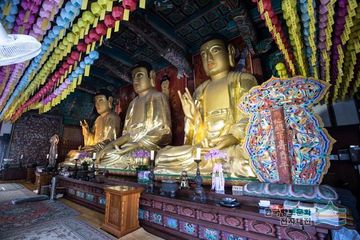완주 송광사 소조석가여래삼불좌상 및 복장유물
| 완주 송광사 소조석가여래삼불좌상 및 복장유물 Clay Seated Sakyamuni Buddha Triad and Excavated Relics of Songgwangsa Temple, Wanju |
|
 완주 송광사 소조석가여래삼불좌상 및 복장유물, 디지털완주문화대전. |
|
| 대표명칭 | 완주 송광사 소조석가여래삼불좌상 및 복장유물 |
|---|---|
| 영문명칭 | Clay Seated Sakyamuni Buddha Triad and Excavated Relics of Songgwangsa Temple, Wanju |
| 한자 | 完州 松廣寺 塑造釋迦如來三佛坐像 및 腹藏遺物 |
| 주소 | 전북 완주군 소양면 송광수만로 255-16, 송광사 (대흥리) |
| 지정번호 | 보물 제1274호 |
| 지정일 | 1997년 8월 8일 |
| 분류 | 유물/불교조각/소조/불상 |
| 시대 | 조선시대 |
| 수량/면적 | 일괄 (불상 3구, 복장물 2종 6점) |
| 웹사이트 | 완주 송광사 소조석가여래삼불좌상 및 복장유물, 국가문화유산포털, 문화재청. |
|
|
|
해설문
국문
이곳 삼존불은 석가여래를 중심으로 좌우에 약사여래와 아미타여래상을 안치했으며 석가여래는 5.5m, 양쪽 협시불은 5.2m 높이로, 흙으로 빚었고(은) 우리나라 삼존불상 중 큰 편에 든다.
1993년 불상 안에 들어있던 복장유물 12종 가운데 불상조성기 유물 3점, 다섯 개의 거울과 오보병, 수정이 발견된 후령통 3점은 보물로 일괄 지정되었다.
석가여래상에서 나온 조성기에 따르면, 이 삼불좌상은 인조 19년(1641) 6월 29일에 임금과 왕비의 만수무강을 빌고 병자호란 당시 청나라에 볼모로 잡혀간 소현세자와 봉림대군의 무사 귀환을 기원하기 위하여 조성한 것이다. 조선 후기 불교 중흥을 이끌었던 고승 벽암 각성(碧巖 覺性, 1575~1660)이 시주하고, 청헌(淸憲) 등 17인의 승려 조각가가 참여하였다. 임진왜란과 병자호란 이후 국난 극복의 의지를 반영하여 당시의 문화적 역량을 최대한 발휘한 것으로 평가된다.
영문
Clay Seated Sakyamuni Buddha Triad and Excavated Relics of Songgwangsa Temple, Wanju
This Clay Seated Sakyamuni Buddha Triad has Sakyamuni Buddha enshrined at the center with Bhaisajyaguru Buddha and Amitabha Buddha to each side. The Sakyamuni Buddha and the other two statues enshrined here measure in height 5.5m and 5.2m, respectively. It is one of the larger clay Buddha triad still existing in Korea.
Among the relics discovered in 1993 inside the Buddha triad, there were three records about the creation of the statues* along with three containers of votive objects that contained five mirrors, five golden bottles filled with goods**, and crystals, all designated collectively as a treasure.***
According to the records found inside the statue of Sakyamuni Buddha about its creation, this Buddha triad was made in 1641, to wish for the longevity of the king and queen and also for a safe return of Crown Prince Sohyeon and Crown Prince Hyojong**** who were taken hostages to Qing China during the Manchu invasions of 1636-1637. The statue was made by Cheongheon and other 17 monk sculptors with the donation of the eminent monk Gakseong (1575-1660), who is known for leading the revival of Buddhism during the late period of the Joseon period (1392-1910). This Buddha triad is considered to be a work of art that reflects the will to overcome the national crisis after the war and shows fully the cultural power of that time.
- 불상조성기 = 불상 조성기는 발원문(發願文) 또는 복장기(腹藏記)라고도 한다. 여기에는 불상을 조성한 이유, 불상 조성에 참여한 인물들, 불상을 만든 장인들, 불상을 봉안한 장소와 연도 등이 기록되어 있다. (http://www.ibulgyo.com/news/articleView.html?idxno=154894)
출처 : 불교신문(http://www.ibulgyo.com) in (http://dh.aks.ac.kr/~heritage/wiki/index.php/구미_원각사_목조보살좌상) 조성기 is “records about the creation of“
- 오보병 = 오보병은 대일여래의 다섯가지 지혜의 보배
五寶甁, 중앙을 의미하는 황금색 병이다 (https://www.yna.co.kr/view/PYH20150521086200005) 오보병 안에 들어가는 물목은 오곡, 오보, 오약, 오황, 오개자, 오채번, 오색사, 오시화, 오보리수엽, 오길상초, 오산개, 오금강저로서 이들은 각 방위와 계절, 색깔에 맞추어진 물목들이다. (https://m.blog.naver.com/PostView.nhn?blogId=khj900413&logNo=220402254122&proxyReferer=https:%2F%2Fwww.google.com%2F)
- (https://mblogthumb-phinf.pstatic.net/MjAxODAzMDRfMTA4/MDAxNTIwMTM2MjAxNjg5.qXlOhUhUT_JCVKwGQNB-KKzuezCi7sxY2k8yp4VRfqMg.H43qlBvxE2PtED0yzSnQpW5xX7zhBzQXy7s63TqQWhEg.JPEG.waited0220/line_1520131640057.jpg?type=w800) accodring to this picture the 오보병 is inside the 후령통 but I don’t know if the 불상조성기 are also inside the 후령통 so I tried to separate them.
- 봉림대군 is the name of King Hyojong before he became king. Since 대군(大君) means sth like “great noble man” and it was a title (왕의 적자(嫡子)에게 주던 작위) I didn’t know what to put after Bongnim, so I said crown prince.
- (https://mblogthumb-phinf.pstatic.net/MjAxODAzMDRfMTA4/MDAxNTIwMTM2MjAxNjg5.qXlOhUhUT_JCVKwGQNB-KKzuezCi7sxY2k8yp4VRfqMg.H43qlBvxE2PtED0yzSnQpW5xX7zhBzQXy7s63TqQWhEg.JPEG.waited0220/line_1520131640057.jpg?type=w800) accodring to this picture the 오보병 is inside the 후령통 but I don’t know if the 불상조성기 are also inside the 후령통 so I tried to separate them.
영문 해설 내용
이 삼불좌상은 석가여래를 중심으로 좌우에 약사여래와 아미타여래로 구성되어 있다. 석가여래상과 양쪽 협시불상의 높이는 각각 5.5m, 5.2m이며, 한국에 남아있는 흙으로 빚은 삼존불상 중 큰 편에 속한다.
1993년 불상 안에서 발견된 복장유물 중 불상조성기 3점, 다섯 개의 거울과 오보병, 수정이 발견된 후령통 3점이 보물로 일괄 지정되었다.
석가여래상에서 발견된 조성기에 따르면, 이 삼불좌상은 1641년 임금과 왕비의 만수무강을 빌고 병자호란으로 청나라에 볼모로 잡혀간 소현세자와 봉림대군의 무사 귀환을 기원하기 위해 조성한 것이다. 조선 후기 불교 중흥을 이끌었던 고승 각성(1575-1660)이 시주하고, 청헌 등 17명의 승려 조각가가 참여하였다. 전쟁 이후 국난 극복의 의지를 반영하여 당시의 문화적 역량을 최대한 발휘한 것으로 평가된다.
참고자료
- 문화재대관_보물_불교조각 2, 문화재청, 2017. → 불상관련 기본 정보
- 디지털완주문화대전 http://wanju.grandculture.net/wanju/toc/GC07000381 → 이미지출처, 수인 구체적으로 설명.
- (이야기가 있는 조선시대 불상) ⑧ 완주 송광사 석가여래삼불상, 불교신문, 2017.5.10. 기사 http://www.ibulgyo.com/news/articleView.html?idxno=157843 → 조각승 및 벽암각성 관련 정보 제공.